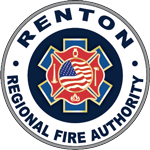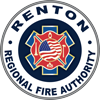Two-Part Funding System
TWO-PART FUNDING EXPLAINED
On April 26, 2016, City of Renton and Fire District 25 voters approved Proposition 1, creating the Renton Regional Fire Authority (RRFA) and the associated funding plan. The funding plan entails a two-part funding system comprised of a Property Tax Levy and a Benefit Charge. Read below to find out more information on each segment of the plan and how they work together to provide stable funding of critical services.
Part 1: Property Tax Levy
A Property Tax Levy is the traditional way in which fire and emergency medical services are funded. The amount that each taxpayer pays is based on assessed property value. With the inception of the Renton RFA, voters also approved its operation and funding plan, which reduced the property tax rate from $1.50 to $1.00 per $1,000 of assessed home value in 2017.
Between 2017 and 2023, the property tax rate continued to decrease due to Washington State law that limits the amount of property tax revenue that can be collected to 1% of additional revenue over the year prior (unless otherwise approved by voters). This limitation did not keep pace with the rising cost of inflation during this time period, which drove the property tax rate down to ensure the appropriate amount of revenue was collected per the law. By 2023, the property tax rate had dropped to $0.61 per $1,000 of assessed property value. To ensure continued funding security, Renton voters approved restoring the property tax rate to $1.00 per $1,000 of assessed property value starting in 2024 and to allow it to adjust for inflation for several additional years. This secured Renton RFA’s funding mechanism for a minimum of 6 years, but potentially even longer.
Funding critical fire and emergency medical services through a property tax has its benefits and drawbacks. While it does guarantee that funds are available year to year, the amount can fluctuate significantly based on what is going on in the economy. When the recent recession hit, property values steadily declined. This decline in property value led to significantly less financial resources for fire stations to provide services to the community.
Additionally, a property tax doesn’t take into consideration the hazards associated with the building or the firefighting resources required to safeguard it. For example, a building owner housing a business that uses combustible gases would pay the same amount as a building owner housing an office, as long as the assessed value of the property was the same.
While the need for property tax funding is still prevalent, creators of the Renton RFA recognized that a secondary funding method could provide more financial stability and more fairly distribute costs for taxpayers. As a result, they introduced the Benefit Charge.
Quick Facts:
- Based solely on assessed property value.
- The 2025 rate is $1.00 per $1,000 of assessed value.
- The Property Tax Levy is included in your annual property taxes automatically, and it is paid directly to Renton RFA by the King County Treasury Division when your property taxes are paid.
Part 2: Fire Benefit Charge
The fire benefit charge (FBC) is assessed differently. It applies to all structures on a parcel 400 square feet or larger, including each level of a building, basements (finished and unfinished), mezzanines, and garages. Factors that help determine the amount each tax payer contributes includes required firefighting resources, size of the building(s), and hazards associated with the building(s).
Under this portion of the two-part funding system, a building owner housing a business that uses combustible gases would have a higher benefit charge than a building owner housing an office. This creates a more equitable relationship between building owners and the fire and life safety services they need to safeguard their occupants and property.
It is also important to note that Renton’s population has rapidly grown in the last two decades and is expected to continue to grow exponentially. More residents and visitors in the community means more fire and medical emergency response calls. The FBC helps ensure that we not only have adequate funds to grow with our growing community, but that those funds are stable and protected.
Quick Facts
- The charge applies to all structures on a parcel over 400 square feet.
- Considers occupancy risk and firefighting resources needed.
- Low income seniors and disabled persons receive the same percentage discount as on their property taxes.
- Revenues can comprise up to 60% of the Renton RFA budget.
- The rate is approved each year by the Governance Board.
- Voters reauthorized the FBC for 10 years during the November 2, 2021 general election.
FUNDING AND RESPONSE TIMES
Minutes matter. It’s important to recognize that funding plays a major role in fire and emergency medical service response times. Stable funding saves lives by ensuring our teams have stations in the right areas, state of the art equipment, and the workforce to provide a swift, life-saving response in emergent situations. When voters approved the two-part funding system, they took a big step forward in helping our organization provide better fire and life safety services throughout the entire Renton community.
Below are two examples of why response times are so critical.
As modern building materials and floor plans have progressed to become more efficient and spacious, they have also become more dangerous when a fire occurs. Building materials and furnishings of today are much more combustible than they were just a few decades ago. Likewise, our desire to have open, airy floor plans also plays an impactful role in how easy it is for a fire to spread within a room and beyond.
The video to the left was made by the Fire Safety Research Institute and shows the difference in fire risk between the common types of home furnishing materials that were used in the past vs. the highly-combustible materials in modern homes and buildings today. Keep an eye on the clock! In less than five minutes, the modern home is completely engulfed in flames.
This is a great example of why proper funding is so critical. It is easy to see how being able to provide the fastest response time possible can have a significant impact on our organization’s ability to save lives and property.
Sudden Cardiac Arrest (SCA) is the third leading cause of death in the U.S. SCA is an electrical disturbance of the heart that causes a lack of blood to vital organs, including the brain. Brain death in cardiac arrest patients begins within minutes. Without immediate medical intervention, cardiac arrest patients have a slim chance of survival.
Through proper funding, our teams are able to obtain both the necessary training and aid equipment to reverse the effects of cardiac arrest and return patients to normal arrhythmia. Arriving on the scene of an emergency quickly and administering the proper support can mean the difference between life and death. The resources provided by the two-part funding system help ensure expedient responses by our highly trained firefighters, keeping our community safer and healthier.


